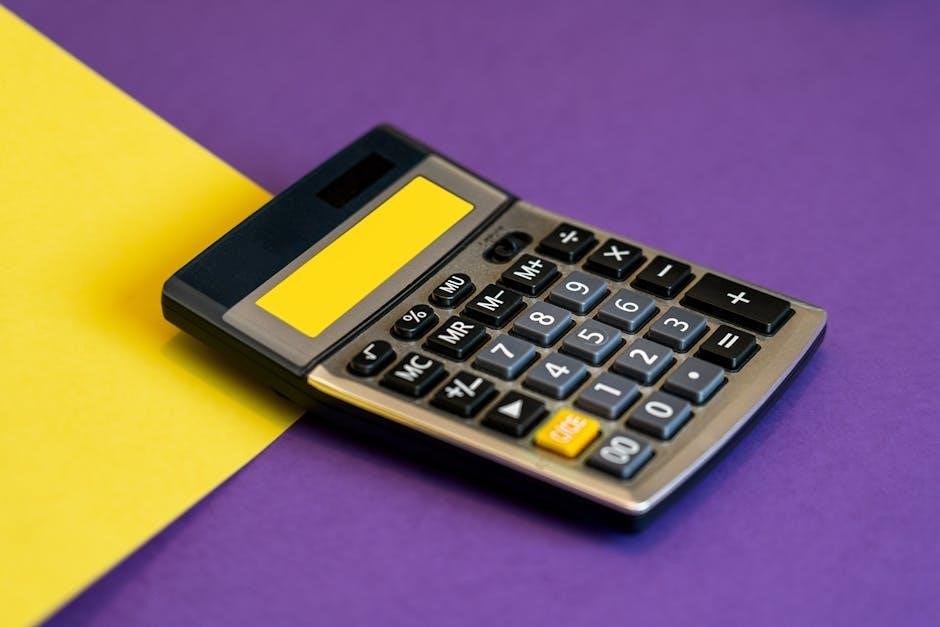multiplication of decimals worksheets pdf
Multiplying decimals is a fundamental skill essential for everyday calculations and academic success. Worksheets and online resources provide practice, ensuring accuracy and confidence in mastering decimal multiplication.
Understanding the Basics of Decimal Multiplication
Multiplying decimals involves aligning numbers by their decimal points and treating them like whole numbers during calculation. After multiplying, count the total decimal places in both numbers to place the decimal point correctly in the product. Practice with worksheets helps master this process, ensuring accuracy and confidence in everyday calculations and problem-solving tasks.
Importance of Mastering Decimal Multiplication
Mastery of decimal multiplication is crucial for everyday calculations and academic success. It ensures accuracy in handling money, measuring quantities, and solving real-world problems. Worksheets provide structured practice, building confidence and fluency. Proficiency in this skill is vital for advanced math, science, and STEM applications, making it an essential foundation for lifelong learning and practical problem-solving.
Key Concepts in Multiplying Decimals
Mastering decimal multiplication involves aligning decimals, counting decimal places, and accurate placement of the decimal point in the product. Worksheets provide structured practice to reinforce these essential skills effectively.
Aligning Decimals and Place Value
Properly aligning decimals ensures accurate calculations. When multiplying, write decimals vertically, aligning the decimal points. This method maintains place value integrity, preventing errors. Worksheets emphasize this technique, helping learners develop a strong foundation in decimal multiplication through consistent practice and clear examples.
Counting Decimal Places for Accuracy
Counting decimal places is crucial for precise multiplication. Track the number of digits after the decimal in both numbers, then apply this total to the product. This ensures the decimal point is correctly placed, avoiding errors. Worksheets often highlight this step, providing structured problems to practice and master accurate decimal placement for reliable results.

Step-by-Step Guide to Multiplying Decimals
Multiply decimals by treating them as whole numbers initially. After obtaining the product, count the total number of decimal places from both factors and place the decimal point accordingly for accuracy.
Multiplying Decimals by Whole Numbers
Multiplying decimals by whole numbers involves treating the decimal as a whole number during multiplication. For example, to multiply 4;16 by 9, multiply 416 by 9, which equals 3,744. Then, place the decimal point three places to the left, resulting in 37.44. This method ensures accuracy and simplifies the process.
Multiplying Decimals by Decimals
Multiplying decimals by decimals requires multiplying as if they were whole numbers, then counting the total number of decimal places in both numbers. For example, multiplying 0.41 by 0.52 involves multiplying 41 by 52 to get 2132, then placing the decimal four places left, resulting in 0.02132. This ensures precise results in calculations.
Adding Zeros for Placeholding
Adding zeros as placeholders simplifies decimal multiplication, especially when multiplying decimals by whole numbers. For example, multiplying 4.16 by 9.11 involves aligning decimals and adding zeros to whole numbers to maintain place value accuracy. This technique ensures correct placement of the decimal point in the final product, reducing calculation errors and improving precision.

Using Worksheets for Practice
Free PDF worksheets are ideal for practicing decimal multiplication, offering various problems to improve skills. They provide structured exercises, from basic to advanced, ensuring comprehensive learning and mastery of decimal operations.
Locating Free PDF Worksheets Online
Locating Free PDF Worksheets Online
Free PDF worksheets for decimal multiplication are easily accessible online. Websites like Kuta Software, Super Teacher Worksheets, and EffortlessMath.com offer a variety of exercises. Search for “multiplying decimals worksheets PDF” to find resources. Many sites provide customizable options, ensuring you can tailor practice to your skill level or teaching needs effectively.
Choosing the Right Worksheet for Your Needs
When selecting a worksheet, ensure it aligns with your skill level and learning objectives. Look for resources offering varied problem types, such as whole numbers, decimals, and mixed numbers. Check for features like answer keys and progress tracking. Opt for worksheets that allow customization to focus on specific areas needing improvement, ensuring targeted practice and better retention of concepts.
Utilizing Answer Keys for Verification
Answer keys are essential for verifying solutions and ensuring accuracy. They help identify mistakes, allowing for immediate correction and better understanding. Use them to check completed worksheets, focusing on common errors like decimal placement. Detailed solutions in PDFs provide clarity, reinforcing learning and building confidence in multiplication skills over time.
Real-World Applications of Decimal Multiplication
Decimal multiplication is crucial in everyday scenarios like shopping, cooking, and STEM fields. It aids in calculating monetary values, measuring ingredients, and scaling recipes accurately, ensuring precision in various tasks.
Calculating Monetary Values
Multiplying decimals is essential for calculating monetary values accurately. Whether budgeting, handling discounts, or splitting bills, this skill ensures precise financial management in real-life scenarios. Worksheets offer practical exercises to master these calculations, enhancing both mathematical proficiency and financial literacy for everyday transactions.
Measuring Quantities Accurately
Multiplying decimals is crucial for precise measurement in cooking, construction, and science. Accurate calculations ensure consistency and efficiency, whether scaling recipes or mixing materials. Worksheets provide exercises to refine these skills, helping users avoid errors and achieve exact measurements in real-world applications.
Science, Technology, Engineering, and Math (STEM) Uses
Decimal multiplication is vital in STEM fields for calculations involving measurements, data analysis, and engineering design. Worksheets with STEM-focused problems help students apply decimal multiplication to real-world scenarios, improving their problem-solving skills and preparing them for careers in science, technology, and engineering.

Tips for Teaching and Learning
Read questions carefully, show all work for clarity, and use online resources effectively. Practice regularly with worksheets and verify answers using keys for accuracy and understanding.
Reading Questions Carefully
Reading questions carefully ensures understanding of the numbers and decimal places involved. Highlight key details, like the position of decimal points, to avoid errors. Double-checking the question helps in aligning decimals correctly during calculations, leading to accurate results and better problem-solving skills in decimal multiplication tasks.
Showing All Work for Clarity
Showing all work ensures clarity and accuracy in decimal multiplication. Write each step neatly, aligning decimals properly to avoid misplacement of the decimal point. This helps in identifying errors and verifying solutions using answer keys from worksheets, fostering confidence and improving problem-solving skills in decimal multiplication tasks.
Using Online Resources Effectively
Online resources like Kuta Software and Corbettmaths offer interactive PDF worksheets for decimal multiplication practice. Utilize answer keys for verification and customize worksheets to suit skill levels. Videos and step-by-step guides enhance understanding, while printable formats provide convenience. These tools ensure efficient learning and mastery of decimal multiplication concepts for students of all ages.
Common Mistakes to Avoid
Misplacing the decimal point and ignoring decimals during calculations are common errors. Always align decimals properly and count decimal places for accurate results in multiplication problems.
Misplacing the Decimal Point
Misplacing the decimal point is a common error that can significantly affect results. Always count decimal places carefully and use place value charts for alignment. Labeling decimal positions during calculations helps prevent this mistake. For example, in 1.2 x 4, ensure the decimal remains after the “1” in the product. Practicing with worksheets builds confidence and accuracy in placing decimals correctly.
Ignoring the Decimal in Calculations
Ignoring the decimal point during multiplication leads to incorrect results, often by factors of 10 or more. Always recognize and include decimals in both numbers and products. For example, in 1.2 x 4, failing to account for the decimal results in 12 instead of 4.8. Worksheets emphasize proper decimal handling to avoid such errors and ensure accuracy in calculations;
Advanced Problems in Decimal Multiplication
Advanced problems involve multiplying large numbers with multiple decimal places, requiring precise alignment and careful counting of decimal places to ensure accuracy in complex calculations.
Multiplying Large Numbers with Decimals
Multiplying large numbers with decimals requires careful handling of decimal points and precise alignment. For example, multiplying 68.2 by 8.4 involves counting decimal places and ensuring proper placement in the final product. Worksheets often include problems like 32.3 x 1.2, emphasizing the importance of accuracy and attention to detail in complex calculations to avoid errors.
Handling Mixed Numbers and Decimals
Converting mixed numbers to improper fractions before multiplying by decimals simplifies calculations. For example, 1 1/2 (or 3/2) multiplied by 0.5 equals 1.5. Worksheets often include exercises like 2 3/4 x 0.75, ensuring students master this skill by practicing proper conversion and multiplication techniques to achieve accurate results consistently.

The Future of Learning Decimal Multiplication
The future involves interactive PDF worksheets and math learning apps, making decimal multiplication engaging and accessible. Technology enhances practice, ensuring mastery through innovative tools and personalized learning experiences for all skill levels.
Interactive PDF Worksheets
Interactive PDF worksheets offer enhanced learning experiences with self-checking features, customizable problems, and visual guides. They allow real-time feedback, enabling students to identify mistakes instantly. These dynamic tools make practicing decimal multiplication engaging and efficient, catering to diverse learning styles. Additionally, they can be easily shared and accessed, promoting flexible learning environments for students of all ages and skill levels.
Math Learning Applications
Math learning apps provide interactive platforms for mastering decimal multiplication. They offer step-by-step guides, video tutorials, and practice exercises with real-time feedback. Apps like Khan Academy, Mathway, and Photomath cater to various learning styles, making decimal multiplication engaging and accessible; These tools help students build confidence and fluency in a structured, tech-driven environment, anytime and anywhere.
Summarizing Key Takeaways
Mastering decimal multiplication requires consistent practice and attention to detail. Worksheets, such as multiplication of decimals worksheets PDF, provide structured exercises to improve accuracy. Key concepts include aligning decimals, counting decimal places, and avoiding common errors like misplacing the decimal point. Regular practice with these resources ensures fluency and confidence in handling real-world calculations.
Encouraging Continued Practice
Consistent practice is vital for mastering decimal multiplication. Utilize multiplication of decimals worksheets PDF to reinforce skills and build confidence. Interactive resources like Kuta Software and Corbettmaths offer diverse exercises, ensuring comprehensive understanding. Regular practice with these tools helps maintain momentum and accelerates proficiency in handling various decimal multiplication challenges effectively.
